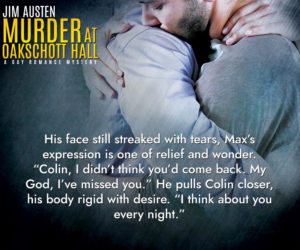About the Book
In the Junior students’ dormitory at Oakschott Hall, a heavy gaslight falls from the ceiling, crushing the head of a student sleeping beneath it. Was it simply a tragic accident? To avoid publicity, the Headmaster asks Colin Revell, a young Oxford University graduate and former Oakschott student, to quietly investigate.
 While interviewing the faculty and staff, Colin meets Max Lambourne, a handsome don who was wounded and gassed in WWI. When Colin tries to help Max overcome his trauma and depression, the two men fall in love and begin an erotic affair.
While interviewing the faculty and staff, Colin meets Max Lambourne, a handsome don who was wounded and gassed in WWI. When Colin tries to help Max overcome his trauma and depression, the two men fall in love and begin an erotic affair.
But when another student dies—diving at night into an empty swimming pool—murder is suspected. Students and faculty all come under suspicion, and rumors proliferate when Scotland Yard intervenes. Meanwhile, during all this confusion and wild theories, the murderer sees Colin and Max as threats. Unbeknownst to the two lovers, their lives are now in danger.
Why I wrote it
Although the novel Murder at School by James Hilton (of Goodbye, Mr. Chips fame) has no gay characters, the book had an unspoken homoeroticism that demanded liberation. Any novel about an all-boys public school is fertile ground for gay themes.
Although there are no gay references in the original novel, I was struck by one scene in which the headmaster asks a former student:
“Are you interested, by the way, in etchings? I have one or two that are considered rather choice.”
I laughed when I read that. This is the timeworn proposition employed by the licentious cad who tempts a young woman he hopes to seduce up to his rooms. What was James Hilton thinking when he added this short scene to his novel?
The deciding factors to “mash” in a gay storyline were the two young men, Colin and Max, as the central characters. Their friendship in the original text is not sexual but making them gay lovers almost wrote itself.
